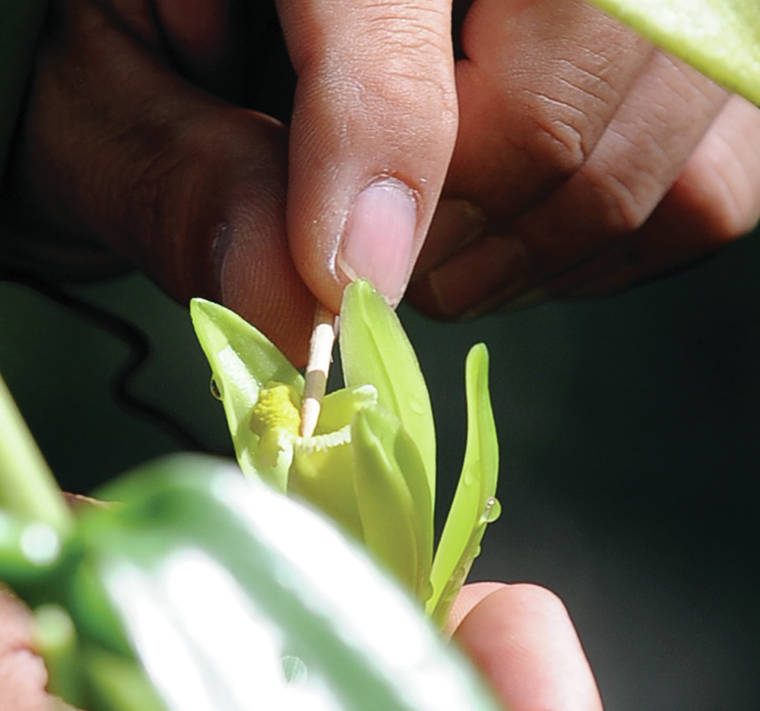
Here in Hawaii, we can grow lots of wonderfully exotic tropical plants year round. The vanilla orchid vine is one of these that requires special care but can produce lovely flowers and a tasty product. The vanilla “bean” appears as a pod following pollinated flowers. After months on the vine and more months of curing, you will have grown and cured your own vanilla flavoring. Read on if this appeals to you.
Vanilla is one of the world’s most expensive spices for good reason. It is also one of the world’s most labor-intensive crops. On a small scale, on your farm or in your garden, it can be fun to grow as long as you are able to check it daily for blooms and are willing to learn how to pollinate the flowers in order to get pods full of tiny vanilla-flavored seeds.
Vanilla planifolia is the botanical name for the species of vanilla vine that produces the familiar spice. The genus Vanilla includes more than 100 species and is a member of the largest flowering plant family the Orchidaceae. Seven hundred genera and about 20,000 species comprise this huge family.
The vine that produces vanilla is likely native to Mexico’s gulf coast where the Totonac people believed the plant grew from the blood of a mythical princess as a gift from the gods. When the Aztecs conquered the Totonacs in the 15th century, they acquired the vanilla plants and their cultivation spread. By the 16th century vanilla plants were being grown in Spain and vanilla was becoming a popular flavor in Europe. Today, vanilla is grown throughout the tropics.
Over the years, several small-scale commercial operations sprung up in Hawaii to grow vanilla.
One of the oldest commercial vanilla ventures on the Big Island emanated from the work of Kona orchid grower Tom Kadooka. In 1998, Jim and Tracy Reddekopp worked with Kadooka to establish vanilla vines in several large shade houses on their Hamakua property. Though both Tom and Jim are gone, the Hawaiian Vanilla Co. is still open and growing lots of vanilla. The Vanillerie in Kailua-Kona and the Vanillery of Kauai round out the known commercial vanilla producers in the state.
You don’t need to be a commercial vanilla producer to start and cultivate a few plants on your property, however. They grow as vines and need partial shade, some moisture, rich soil that drains well as well as good support for their clinging roots in order to thrive.
Vanilla plants produce fleshy sword-shaped leaves that are spaced along the stem. When they reach two to three years old, showy greenish yellow vanilla orchids will appear on racemes that support several blossoms. The flowers can be up to 3 inches across but they only stay open for a single day. They require pollination on that day in order to produce the pods that contain the vanilla flavored seeds.
In their native habitats, insect pollinators for vanilla orchids abound, like the Melipona bee. Here in Hawaii, pollination by hand is the best way to guarantee results. The process involves taking a speck of pollen about the size of a sesame seed from under the flower’s pollen cap and placing it on the stigma. Though several techniques work, it is best to find one that works for you and practice it.
After the flowers drop, a pod will begin to form and grow for about nine months before it is ready to harvest at between 4 and 6 inches long. Though you can leave the pod on the vine to cure, better appearance and flavor is achieved by hand-curing.
The curing process involves heating and drying the pods while keeping them pliable and allowing the seeds in them to ferment slightly for optimum flavor. Check out a 2013 West Hawaii Today article that outlines the process at https://ift.tt/3ngia0f.
Vanilla plants can be easily propagated from cuttings. Placing them in a moist medium that drains well usually results in a new-rooted plant in a few months. Though they can be successfully grown from sea level to 2,500 feet, they do best between 500 feet and 1,000 feet.
Fertilizing lightly every few months will help your plants to grow. Feeding the soil with compost can also create a favorable growing environment for vanilla plants.
Since vanilla grows in moist areas, you need to monitor for fungal diseases as well as slug and snail attacks. If these appear check with the Master Gardener helpline for assistance.
Currently, a group of Kona Master Gardeners are cultivating vanilla plants, pollinating the flowers, processing the pods and propagating new plants from their productive vines. The group is currently selling well-established plants in one-gallon pots for $25 at the UH-CTAHR Cooperative Extension office in Kainaliu.
For more information, call 322-4893 between 9 a.m. and noon on Tuesdays and Thursdays.
Just know that the sensory pleasures this exotic tropical orchid provides, make the effort you put in to growing, cultivating and processing totally worth it.
Diana Duff is a plant adviser, educator and consultant living part time in Kailua-Kona.
"tasty" - Google News
October 04, 2020 at 05:05PM
https://ift.tt/3lbef2X
Plant of the Month: Vanilla provides lovely flowers and a tasty product - West Hawaii Today
"tasty" - Google News
https://ift.tt/2VXquX3
https://ift.tt/3c08sJp
Bagikan Berita Ini















0 Response to "Plant of the Month: Vanilla provides lovely flowers and a tasty product - West Hawaii Today"
Post a Comment